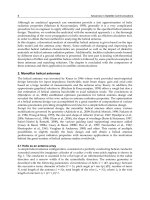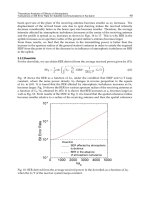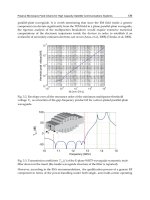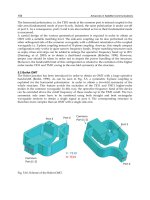Advances in Applied Biotechnology Part 2 pot
Bạn đang xem bản rút gọn của tài liệu. Xem và tải ngay bản đầy đủ của tài liệu tại đây (2.67 MB, 20 trang )
Biotechnology of Agricultural Wastes Recycling Through Controlled Cultivation of Mushrooms
9
experiments were conducted under the following conditions: temperature, 25°C; agitation
speed, 120-180 rev min
-1
; initial pH, 4.5–5.5. After 10–12 d of incubation the fungal cultures
were ready to be inoculated aseptically into the glass vessel of 20 l laboratory-scale
bioreactor, that was designed to be used for controlled submerged cultivation of edible and
medicinal mushrooms on substrata made of wastes resulted from the industrial processing
of cereal grains (Fig. 5).
Fig. 5. General view of the Laboratory scale bioreactor (15 L)
After a period of submerged fermentation lasting up to 120 h, small mushroom pellets
developed inside the nutritive broth (Fig. 6, 7).
Fig. 6. Mycelial biomass of G. lucidum collected after submerged fermentation
Advances in Applied Biotechnology
10
Fig. 7. Mycelial biomass in the shape of fungal pellets of L. edodes, collected after submerged
fermentation
The fermentation process was carried out by inoculating the growing medium volume
(10,000 ml) with mycelia inside the culture vessel of the laboratory-scale bioreactor. The
whole process of growing lasts for a single cycle between 5-7 days in case of L. edodes and
between 3 to 5 days for G. lucidum. The strains of these fungal species were characterized by
morphological and cultural stability, proven by their ability to maintain the phenotypic and
taxonomic identities. The experiments were carried out in three repetitions. Observations on
morphological and physiological characters of these two tested species of fungi were made
after each culture cycle, highlighting the following aspects:
- sphere-shaped structure of fungal pellets, sometimes elongated, irregular, with various
sizes (from 2 to 5 mm in diameter), reddish-brown colour – G. lucidum culture (Fig. 8).
Fig. 8. Stereomicroscopic view of G. lucidum pellets after controlled submerged fermentation
Biotechnology of Agricultural Wastes Recycling Through Controlled Cultivation of Mushrooms
11
- elliptically-shaped structures of fungal pellets, with irregular diameters of 4 up to 7 mm
showing mycelia congestion, which developed specific hyphae of L. edodes (Fig. 9).
Fig. 9. Stereomicroscopic view of L. edodes pellets after controlled submerged fermentation
Samples for analysis were collected at the end of the fermentation process, when pellets
formed specific shapes and characteristic sizes. The fungal biomass was washed repeatedly
with double distilled water in a sieve with 2 mm diameter eye, to remove the remained bran
in each culture medium.
3.1 Results and discussion
Biochemical analyses of fungal biomass samples obtained by submerged cultivation of
mushrooms were carried out separately for the solid fraction and liquid medium remained
after the separation of fungal biomass by filtering. The percentage distribution of solid
substrate and liquid fraction in the samples of fungal biomass are shown in table 1.
Mushroom species
Total volume of
separated liquid per
sample (ml)
Total biomass weight
per sample (g)
Water content after
separation (%)
L. edodes
83 5.81 83.35
L. edodes
105 7.83 82.50
L. edodes
95 7.75 82.15
L. edodes
80 5.70 79.55
G. lucidum
75 7.95 83.70
G. lucidum
115 6.70 82.95
G. lucidum
97 5.45 80.75
G. lucidum
110 6.30 77.70
Table 1. Percentage distribution of solid substrate and liquid fraction in the preliminary
samples of fungal biomass
Advances in Applied Biotechnology
12
In each experimental variant the amount of fresh biomass mycelia was determined. The
percentage amount of dry biomass was determined by dehydration at 70°C, up to constant
weight. Total protein content was determined by biuret method, whose principle is similar
to the Lowry method, this method being recommended for the protein content ranging from
0.5 to 20 mg/100 mg sample. In addition, this method required only one sample incubation
period (20 min) and by using them was eliminated the interference with various chemical
agents (ammonium salts, for example).
The principle method is based on reaction that takes place between copper salts and
compounds with two or more peptides in the composition in alkali, which results in a red-
purple complex, whose absorbance is read in a spectrophotometer in the visible domain
(λ - 550 nm). The registered results are presented as the amounts of fresh and dry biomass as
well as protein contents for each fungal species and variants of culture media (Tables 2, 3).
Culture variants Fresh biomass (
g
)Dr
y
biomass (%) Total protei
n
(
g
% d.w.)
I 20.30 5.23 0.55
II 23.95 6.10 0.53
III 22.27 4.79 0.73
IV 20.10 4.21 0.49
Control 4.7 0.5 0.2
Table 2. Fresh and dry biomass and protein content of L. edodes after submerged
fermentation
Culture variants Fresh biomass (g) Dry biomass (%) Total protein (g % d.w.)
I 25.94 9.03 0.67
II 22.45 10.70 0.55
III 23.47 9.95 0.73
IV 21.97 9.15 0.51
Control 5.9 0.7 0.3
Table 3. Fresh and dry biomass and protein content of G. lucidum after submerged
fermentation
According to the registered data, using wheat bran strains the growth of G. lucidum biomass
was favoured, while the barley bran led to the increased growth of L. edodes mycelium and
G. lucidum as well. In contrast, dry matter content was significantly higher when using
barley bran for both species used. Protein accumulation was more intense in case of using
barley bran compared with those of wheat and rye, at both species of mushrooms.
The sugar content of dried mushroom pellets collected at the end of experiments was
determined by using Dubois method (Wasser & Weis, 1994). The mushroom extracts were
prepared by immersion of dried pellets inside a solution of NaOH pH 9, in the ratio 1:5.
All dispersed solutions containing the dried pellets were maintained 24 h at a precise
temperature of 25
0
C, in full darkness, with continuous homogenization to avoid the
oxidation reactions. After removal of solid residues by filtration, the samples were analyzed
by the previous mention method. The nitrogen content of mushroom pellets was analyzed
by Kjeldahl method (Table 4).
Biotechnology of Agricultural Wastes Recycling Through Controlled Cultivation of Mushrooms
13
Mushroom species Culture variant
Su
g
ar content
(
m
g
/ml
)
K
j
eldahl
nitro
g
en
(
%
)
Total protei
n
(g
% d.w.
)
L. edodes
I 5.15 6.30 0.55
L. edodes
II 4.93 5.35 0.53
L. edodes
III 4.50 5.70 0.73
L. edodes
IV 4.35 5.75 0.49
Control 0.55 0.30 0.2
G. lucidum
I 4.95 5.95 0.67
G. lucidum
II 5.05 6.15 0.55
G. lucidum
III 5.55 6.53 0.73
G. lucidum
IV 4.70 5.05 0.51
Control 0.45 0.35 0.3
Table 4. The sugar, total nitrogen and total protein contents of dried mushroom pellets
Comparing all registered data resulted from triple determinations, it can be noticed that the
biochemical correlation between dry weight of mushroom pellets and their sugar and
nitrogen contents is kept at a balanced ratio for each tested mushrooms (Stamets, 2000).
Among all mushroom samples that were tested in biotechnological experiments G. lucidum
G-3 showed the best values of their composition in sugars, total nitrogen and total protein
contents. In this stage, 70-80% of the former fungal pellets were separated by collecting them
from the culture vessel of the bioreactor and separating from the broth by slow vacuum
filtration. On the base of these results, the optimal values of physical and chemical factors
which influence the mushroom biomass synthesis were taken into consideration in order to
established the following schematic flow of the biotechnology for mushroom biomass
producing by submerged fermentation, as it is shown in figure 10.
The main advantages of the submerged fermentation of winery wastes under the metabolic
activity of selected mushrooms, by comparison with the solid state cultivation are the
followings:
a. the shortening of the biological cycle and cellular development in average from 8-10
weeks to at mostly one week per cellular culture cycle;
b. the ensuring of the optimal control of physical and chemical parameters which are
essential for producing important amounts of mushroom pellets in a very short time;
c. 20–30% reduction of energy and work expenses as well as the volume of the volume of
raw materials materials which are manipulated during each culture cycle;
d. 15-20% increasing of fungal biomass amount per medium volume unit for each
mushrooms species;
e. the whole removing of any pollutant sources during the biotechnological flux;
f. the culture media for mushroom growing are integrally natural without using of
artificial additives as it is used in classical cultivating procedures;
g. the mushroom pellets produced by applying this biotechnology for ecological treatment
of agricultural wastes was 100% made by natural means and will be used for food
supplements production with therapeutic properties which will contribute to the
increasing of health level of human consumers having nutritional metabolic deficiencies.
h. the biochemical correlation between the dry weight of mushroom pellets and their sugar
and nitrogen contents is kept at a balanced ratio for each tested mushroom species.
Advances in Applied Biotechnology
14
Pure mushroom cultures
(G. lucidum, L. edodes)
Inoculum preparation from the
liquid mushroom cultures
Adding carbon and nitrogen sources
to the li
q
uid culture media
Steam sterilization of the culture vessel of
the 15 l laboratory-scale bioreactor
Liquid culture medium transfer into
the bioreactor culture vessel
Inoculation of the culture media with liquid mushroom spawn
inside the culture vessel of 15 l laboratory scale bioreactor
Expanding the mushroom
cultures in liquid culture media
Mycelia growing on the liquid culture media
Mushroom pellets formation and development
Mushroom pellets collecting
Mechanical pre-treatment of cereal wastes
by grounding
Fig. 10. Schematic flow of the biotechnology for mushroom biomass producing by
submerged fermentation.
4. The controlled cultivation of mushrooms in modular robotic system
The agricultural works as well as industrial activities related to plant crops and their
processing have generally been matched by a huge formation of wide range of
lignocellulose wastes. All these vegetal wastes cause serious environmental troubles if they
accumulate in the agro-ecosystems or much worse to be burned on the soil. For the human–
operational farms, all processes are made by human personnel exclusively, starting from
filling of cultivation beds with compost, up to fruit-bodies harvesting (Reed et al., 2001).
Biotechnology of Agricultural Wastes Recycling Through Controlled Cultivation of Mushrooms
15
In this respect, a strong tendency for increasing the number of researches in the field of
mushroom’s automated cultivation, harvesting and processing technologies as well as for
continuously development of new robotic equipments can be noticed (Reed et al., 2001).
The solid state cultivation of edible and medicinal mushrooms Lentinula edodes and Pleurotus
ostreatus could be performed by using a modular robotic system that provides the following
fully automatic operations: sterilization of composts, inoculation in aseptic chamber by
controlled injection device containing liquid mycelia as inoculum, incubation as well as
mushroom fruit bodies formation in special growing chambers with controlled atmosphere
and the picking up of edible and medicinal mushroom fruit bodies (Petre et al., 2009).
The biotechnology concerning the controlled cultivation of edible mushrooms in continuous
flow depends on the strictly maintaining of biotic as well as physical and chemical factors
that could influence the bioprocess evolution. The proceeding of edible mushroom
cultivation consists in a continuous biotechological flow, having a chain of succesive stages
that are working in the non-sterile zone and mostly in the sterile zone of the modular robotic
system. In this way, there is provided the technological security both from the structural and
functional points of view in order to produce organic foods in highest security and food
quality. The functional biotechnological model of the modular robotic system was designed
for controlled cultivation and integrated processing of edible mushrooms to get ecological
food in highest safety conditions (Petre et al., 2009).
The modular robotic system designed for edible mushroom cultivation provides the
automatic sterilization of composts, the automatic inoculation inside the aseptic room by a
special device of controlled injection of liquid mycelia, the incubation and fruit bodies
formation in special chambers under controlled atmosphere as well as the automatic
harvesting of mushroom fruit bodies (Petre et al., 2011).
This system includes three major zones, respectively, the non-sterile zone, the sterile zone
and the fruit-body processing zone (Fig. 11).
Thus, during the first stage of the biotechnological flow, in the non-sterile zone of the
cultivation system, a natural and nutritive compost is prepared from sawdust or shavings of
deciduous woody species in the ratio of 30-40 parts per weight (p.p.w.), marc of grapes
chemically untreated, in 20-30 p.p.w., brans of organic cereal seeds (wheat, barley, oat, rye,
rice), in 10-20 p.p.w., yeasts, in 3-5 p.p.w., and powder of marine shells, in 1-3 p.p.w., for pH
adjustment, which then, it is hidrated with demineralized water, in 20-30 p.p.w. In the next
stage, such prepared compost is decanting in polyethylene thermoserilizable bags, which
have round orifices of 0,3-0,5 mm in diameter, uniform distribuited between them, at 10-15
cm distance, each one of them having a working volume of 10-20 kg (Petre et al., 2011).
Beforehand, special devices for uniform distribution of mycelia as liquid inoculum are
mounted inside of these bags. Then, these bags are fitted out with supporting devices on the
transfer and transport systems and special devices for coupling to the automatic inoculation
subdivision by controlled injection of liquid mycelia (Fig. 11).
Each one of these zones is linked with next one by an interfacing zone. In this way, the non-
sterile zone is linked with the sterile zone through the first interfacing zone and this one is
connected with the fruit body processing zone by the second interfacing area, as it is shown
in figure 11.
Advances in Applied Biotechnology
16
Fig. 11. Schematic flow of the modular robotic system for controlled cultivation of edible
mushrooms
Inside the non-sterile zone, the bags filled with composts are placed on the supporting
devices, mounted on the transfer pallets, which are inserted in the first part of the sterile
zone, respectively, in the module of the automatic sterilization with microwave at 120-125
º
C,
and the pallets with bags are automatically chilled in the zone of controlled cooling of
sterilized composts up to the room temperature. These pallets with sterilized bags are
Natural Raw Materials Processing
Filling in the Plastic Bags with Compost
Automatic Microwave Sterilization of Plastic Bags
Filled in with Compost
T H E F I R S T I N T E R F A C E A R E A
N
O
N
S
T
E
R
I
L
E
Z
O
N
E
N
O
N
S
T
E
R
I
L
E
Z
O
N
E
S
T
E
R
I
L
E
Z
O
N
E
S
T
E
R
I
L
E
Z
O
N
E
T H E S E C O N D I N T E R F A C E A R E A
Natural Raw Materials Income
Conditioning and Packaging of Mushroom Fruit Bodies
Automatic Inoculation of Sterilized Plastic Bags
W
ith Li
q
uid M
y
celia
Mycelia Incubation in Automatic Conditioned Rooms
Automatic Harvesting of Mushroom Fruit Bodies
Automatic Control of Fruit Body Formation
Biotechnology of Agricultural Wastes Recycling Through Controlled Cultivation of Mushrooms
17
automatically transferred into the aseptic room to make the inoculation with liquid mycelia
by using a robotic device of controlled injection. Further on, the pallets with the inoculated
bags either are evacuated from the sterile zone or they are automatically transferred to the
incubation and fruit body formation rooms. In these rooms of incubation and fruit body
formation, both the optimal temperature of mycelia growing and the relative air humidity
are provided as well as a constant steril air flow introduced under pressure by using an
automatic device and an adecquate lighting level (Petre et al., 2011; Petre et al., 2009).
In this way, the bags are maintained from 15 up to 30 days, during this time a mycelial net
being formed from the hypha anastomosis having a compact structure and a white-yelowish
color, that covers the whole surface of compost and from which the mushroom fruit bodies
will emerge and develop soon as specific morphological structures of the origin species.
These mushroom fruit bodies were grown and maturated in almost 3-10 days, depending on
the cultivated mushroom species, at constant temperature of 18-21
0
C, air relative humidity
90-95% and controlled aeration at 3-5 air volume exchanges per hour and the suitable
lighting at 2.000-3.000 luxes per hour, for 12 h daily. For the fruit bodies picking-up, the
pallets are automatically discharged by the same robotic system and transferred to the
automatic harvesting zone, where another robotic system automatically collects all the
mushroom fruit bodies by a special designed device to be conditioned and packaged
aseptically (Fig. 11). The modular robotic system designed for edible mushroom cultivation
provides the automatic sterilization of composts, the automatic inoculation inside the
aseptic room by a special device of controlled injection of liquid mycelia, the incubation and
fruit bodies formation in special chambers under controlled atmosphere as well as the
automatic picking-up of mushroom fruit bodies (Reed et al., 2001).
Both interfacing zones were designed to keep the sterile zone at the highest level of food
safety against the microbial contamination. Using this robotic biotechnological model of
mushroom cultivation, the economical efficiency can be significantly increased comparing to
the actual conventional technologies, by shorting the total time of mushroom cultivation
cycles in average with 5-10 days, depending on the mushroom strains that were grown and
providing high quality mushroom fruit bodies produced in complete safety cultivation
system (Petre et al., 2009).
4.1 Results and discussion
To increase the specific processes of cellulose biodegradation of winery and vineyard wastes
and finally induce their bioconversion into protein of fungal biomass, there were performed
experiments to cultivate the mushroom species of P. ostreatus and L. edodes on the following
variants of culture substrata (see Table 5).
Variants of culture substrata Com
p
ositio
n
S1 Winer
y
wastes
S2 Mixture of winer
y
wastes and r
y
e bran 2.5%
S3 Mixture of winer
y
wastes and rise bran 2%
S4 Mixture of vine cuttin
g
s and wheat bran 1%
S5 Mixture of vine cuttin
g
s and barle
y
bran 1.5%
Control Pure cellulose
Table 5. The composition of five compost variants used in mushroom culture
Advances in Applied Biotechnology
18
The fungal cultures were grown by inoculating 100 ml of culture medium with 3-5% (v/v)
of the seed culture and then cultivated at 23-25°C in 250 ml rotary shake flasks. The
experiments were conducted under the following conditions: temperature, 25°C; agitation
speed, 120-180 rev min
-1
; initial pH, 4.5–5.5. After 10–12 d of incubation the fungal cultures
were inoculated aseptically into glass vessels containing sterilized liquid culture media in
order to produce the spawn necessary for the inoculation of 10 kg plastic bags filled with
compost made of winery and vineyard wastes (Petre et al., 2011; Petre et al., 2009).
These compost variants were mixed with other natural ingredients in order to improve the
enzymatic activity of mushroom mycelia and convert the cellulose content of winery and
vineyard wastes into protein biomass. Until this stage, all the technological operations were
handmade. In the next production phases, all the operations were designed to be carried out
automatically by using a robotic modular system, which makes feasible the safety culture of
edible mushrooms in continuous flow using as composts the winery and vineyard wastes.
The modular robotic system designed for edible mushrooms cultivation provides the
automatic sterilization of composts, the automatic inoculation inside the aseptic room by a
special device of controlled injection of liquid mycelia, the incubation and fruit bodies
formation in special chambers under controlled atmosphere and the automatic picking-up of
mushroom fruit bodies. In this way, the whole bags filled with compost have to be sterilized
at 90-100
0
C, by introducing them in a microwave sterilizer. In the next stage, all the
sterilized bags must be inoculated with liquid mycelia, which have to be pumped through
an aseptic injection device (Fig. 12).
Fig. 12. General overview of the modular robotic system for controlled cultivating of
mushrooms
Then, all the inoculated bags have to be transferred inside the growing chambers for
incubation. After a time period of 10-15 d from the sterilized plastic bags filled with
compost, the first buttons of the mushroom fruit bodies emerged.
Biotechnology of Agricultural Wastes Recycling Through Controlled Cultivation of Mushrooms
19
For a period of 20-30 d there were harvested between 1.5 – 3.5 kg of mushroom fruit bodies
per 10 kg compost bag. The specific rates of cellulose biodegradation were determined using
the direct method of biomass weighing the results being expressed as percentage of dry
weight (d.w.) before and after their cultivation. The registered data are presented in Table 6.
Variants of culture
substrata
Before cultivation (g% d.w.) After cultivation (g% d.w.)
L. edodes P. ostreatus L. edodes P. ostreatus
S1 2.6-2.7 2.7-2.9 0.5 0.9
S2 2.3-2.5 2.5-2.8 0.4 0.7
S3 2.3-2.5 2.3-2.5 0.5 0.4
S4 2.5 -2.7 2.5 -2.7 0.7 0.8
S5 2.7-2.9 2.5-2.7 0.5 0.7
Control 3.0 3.0 1.4 1.5
Table 6. The rate of cellulose degradation of culture substrata during the growing cycles of
L. edodes and P. ostreatus
The registered data revealed that by applying this biotechnology, the winery and vineyard
wastes can be recycled as useful raw materials for mushroom compost preparation in order
to get significant production of mushrooms.
In this respect, the final fruit body production during the cultivation of these two mushroom
species was registered as being between 20–28 kg relative to 100 kg of composts made of
winery wastes.
Significant bioconversion increasing of the winery and vineyard wastes by using the
modular robotic system of continuous controlled cultivation of edible mushrooms can be
achieved by:
a. using pure strains of the mushroom species P. ostreatus and L. edodes whose biomass has
got nutritive and functional properties proved by the research results of some achieved
projects or others that are running now;
b. excluding any potential contamination sources for the edible mushrooms by using total
sterilization or filtration equipments in each production module, by controlling all raw
and auxiliary materials, water and air;
c. keeping the high precision and accuracy of the inoculation operations, incubation and
fruit body formation of edible mushrooms which induce constant biomass composition
of either fungal mycelia or mushroom fruit bodies;
d. avoiding all errors in the sterile zone of production flow as well as the potential risk of
edible mushroom contamination by the human operators.
5. Conclusions
According to the previous mentioned results, the following conclusions can be drawn:
1. Most suitable organic compost for mycelia growing was prepared from marc of grapes,
showing the highest influence upon the mycelia growing and fresh mushroom
production of 32–35 g%.
Advances in Applied Biotechnology
20
2. From the tested nitrogen sources, barley bran was the most efficient upon the mycelia
growing and fruit mushroom producing at 35-40 g%, being closely followed by rice
bran at 25–30 g% both in case of P. ostreatus and L. edodes, all data being reported as
fresh biomass.
3. Among the tested mineral sources, the natural calcium carbonate (CaCO
3
) yielded the
best mycelia growing as well as fungal biomass production at 28-32 g%; for this reason
it was registered as the most appropriate mineral source being followed by natural
gypsum (CaSO
4
· 2 H
2
O) at 20-23 g%.
4. The originality and novelty of this biotechnology of winery and vineyard wastes
recycling was confirmed by the Patents no 121717/2008 and 121718/2008 issued by the
Romanian Office of Patents and Trade Marks
5. The mushroom pellets produced by applying the controlled cultivation of mushrooms
as biotechnology for ecological treatment of winery wastes was 100% made by natural
means and will be used for food supplements production with therapeutic properties
which will contribute to the increasing of health level of human consumers with
nutritional metabolic deficiencies.
6. The biochemical correlation between the dry weight of mushroom pellets and their
sugar and nitrogen contents was kept at a balanced ratio for each tested mushroom
species.
Among all mushroom samples that were tested in biotechnological experiments G. lucidum
G-3 had shown the best values of its composition in sugars, total nitrogen and total protein
content.
7. The originality and novelty of these biotechnological procedures to recycle the cereal
wastes in order to get high nutritive biomass of mushroom pellets were confirmed
through the Patents no 121677/2008, 121678/2008 and 121679/2008 issued by the
Romanian Office of Patents and Trade Marks
8. By applying the biotechnology of controlled cultivation of edible mushrooms in
modular robotic system, the final fruit body productions of both mushroom species P.
ostreatus as well as L. edodes were registered as being between 20–28 kg relative to 100
kg of composts made of winery wastes.
9. The continuous controlled cultivation of edible mushrooms by using the modular
robotic system can be achieved by:
a. using pure strains of the mushroom species P. ostreatus and L. edodes whose
biomass has got nutritive and functional properties proved by the research results
of some achieved projects or others that are running now;
b. excluding any potential contamination sources for the edible mushrooms by using
total sterilization or filtration equipments in each production module, by
controlling all raw and auxiliary materials, water and air;
c. keeping the high precision and accuracy of the inoculation operations, incubation
and fruit body formation of edible mushrooms which induce constant biomass
composition of either fungal mycelia or mushroom fruit bodies;
d. avoiding all errors in the sterile zone of production flow as well as the potential
risk of edible mushroom contamination by the human operators.
Biotechnology of Agricultural Wastes Recycling Through Controlled Cultivation of Mushrooms
21
10. The originality and novelty of this biotechnology of controlled cultivation of edible
mushrooms in modular robotic system were confirmed by the Patent no 123132/20010,
issued by the Romanian Office of Patents and Trade Marks.
6. Acknowledgment
All these works were supported by the Romanian Ministry of Education and Research
through the Projects no. 51-002/2007 and 52143/2008 in the frame-work of the 4
th
Programme of Research and Development – „Partnership in priority domains“
7. References
Bae, J.T.; Sinha, J.; Park, J.P.; Song, C.H. & Yun, J.W. (2000). Optimization of submerged
culture conditions for exo-biopolymer production by Paecilomyces japonica. Journal of
Microbiology and Biotechnology, Vol. 10, pp. 482-487, ISSN: 1017-7825
Carlile, M.J. & Watkinson, S.C. (1996). Fungi and biotechnology. In: The Fungi, M.J. Carlile,
S.C. Watkinson (Eds.), 253-264, Academic Press, ISBN: 0-12-159960-4, London,
England
Chahal, D.S. (1994). Biological disposal of lignocellulosic wastes and alleviation of their toxic
effluents. In: Biological Degradation and Bioremediation of Toxic Chemicals, G.R.
Chaudry (Ed.), 347-356, Chapman & Hall, ISBN: 978-0-412-62290-8, London,
England
Jones, K. (1995). Shiitake – The Healing Mushroom. Healing Arts Press, Rochester, ISBN: 0-
89281-499-3, Vermont, USA
Moo-Young, M. (1993). Fermentation of cellulose materials to mycoprotein foods,
Biotechnology Advances, Vol. 11, No. 3, pp. 469-482, ISSN: 0734-9750
Moser, A. (1994). Sustainable biotechnology development: from high-tech to eco-tech. Acta
Biotechnologica, Vol. 12, No. 2, pp. 10-15, ISSN: 0138-4988
Oei, P. (2003). Mushroom Cultivation. 3rd Edition, Backhuys Publishers, ISBN: 90-5782-137-
0, Leiden, The Netherlands
Petre, M.; Teodorescu, A.; Bejan, C.; Giosanu, D. & Andronescu, A.(2011). Enhanced
Cultivation of Edible and Medicinal Mushrooms on Organic Wastes from Wine
Making Industry. In: Proceedings of the International Conference „Environmental
Engineering and Sustainable Development“, pp. 234-239, ISBN: 978-606-613-002-8,
Alba Iulia, Romania, May 26-28, 2011
Petre, M. & Teodorescu, A. (2010). Handbook of submerged cultivation of eatable and medicinal
mushrooms. CD Press, ISBN: 978-606-528-087-8, Bucharest, Romania
Petre, M.; Teodorescu, A.; Tuluca, E.; Bejan, C. & Andronescu, A. (2010). Biotechnology of
Mushroom Pellets Producing by Controlled Submerged Fermentation. Romanian
Biotechnological Letters, Vol 12, No. 2, pp. 50-56, ISSN: 1224-5984
Petre, M. & Teodorescu, A. (2009): Ecological Biotechnology for Agro-Food Wastes
Valorization. In: Biotechnology of Environmental Protection, M. Petre (Ed.), vol. 2, 2
nd
Edition, 143-150, CD Press, ISBN: 978-606-528-040-3; 978-606-528-042-7, Bucharest,
Romania
Petre, M.; Teodorescu, A.; Nicolescu, A.; Dobre, M. & Giosanu , D. (2009). Food
biotechnology for edible mushrooms producing by using a modular robotic system.
In: Proceedings of 2
nd
International Symposium „New Researches in Biotechnology”,
Advances in Applied Biotechnology
22
SimpBTH 2009, Biotechnology Series F–Suppl., pp. 261-269, ISSN:1224-7774,
Bucharest, Romania, November 18-19, 2009
Petre, M. & Petre, V. (2008). Environmental Biotechnology to Produce Edible Mushrooms by
Recycling the Winery and Vineyard Wastes. Journal of Environmental Protection and
Ecology, Vol. 9, No.1, pp. 88-95, ISSN: 1311-5065
Petre, M.; Bejan, C.; Visoiu, E.; Tita, I. & Olteanu, A. (2007). Mycotechnology for optimal
recycling of winery and vine wastes. International Journal of Medicinal Mushrooms,
Vol. 9, No. 3, pp. 241-243, ISSN: 1521-9437
Reed, J.N.; Miles, S.J; Butler, J.; Baldwin, M. & Noble, R. (2001). Automation and Emerging
Technologies for Automatic Mushroom Harvester Development. Journal of
Agricultural Engineering Research, Vol 33, pp. 55-60, ISSN: 1095-9246
Smith, J. (1998). Biotechnology. 3
rd
Edition. Cambridge University Press, ISBN: 0-521-44911-
1, London, England
Stamets, P. (2000). Growing Gourmet and Medicinal Mushrooms. Ten Speed Press, ISBN: 1-
58008-175-4, Berkeley, Toronto, Canada
Verstraete, W. & Top, E. (1992). Holistic Environmental Biotechnology. Cambridge
University Press, ISBN: 0-521-42078-4, London, England
Wasser, S.P. & Weis, A.L. (1994). Therapeutic effects of substances occurring in higher
Basidiomycetes mushrooms: a modern perspective. Critical Reviews in Immunology,
Vol. 19, pp. 65-96, ISSN: 1040-8401
2
Total Recycle System of Food Waste
for Poly-L-Lactic Acid Output
Kenji Sakai
1
, Pramod Poudel
1,2
and Yoshihito Shirai
3
1
Graduate School of Bioresource and Bioenvironmental Sciences,
Faculty of Agriculture, Kyushu University, Fukuoka,
2
National College (NIST), Department of Microbiology,
Tribhuvan University, Kathmandu,
3
Graduate School of Life Science and Systems Engineering,
Kyushu Institute of Technology, Kitakyushu, Fukuoka,
1,3
Japan
2
Nepal
1. Introduction
1.1 Impacts of food waste
Food waste is defined as wholesome edible material intended for human consumption arising
at any point in the food supply chain that is instead discarded, lost, degraded or consumed by
pests. The average consumer in Europe and North-America throws away ca. 100 kg of food
per year according to a new report published by the UN’s Food and Agriculture Organization
(Annual report of FAO, 2011 & Parfitt et al., 2010). The study centers on food loss and food
waste during the whole supply chain from production to consumption and finds that around
“one-third of the edible parts of food produced for human consumption gets lost or wasted
globally” representing about 1.3 billion ton per year. Around 20% of about 50 metric tons of
waste that is generated annually in Japan is high moisture content refuse from kitchens and
the food industries. The social, economic and environmental impacts of food waste are
enormous. Such wastes readily decompose, generate odors, and sometimes cause illnesses.
Municipal solid wastes including food waste are usually incinerated or land filled which
ultimately generates many problems such as liberation of harmful compounds like dioxin and
furans (Addink & Olie, 1995). Incineration facilities can be damaged by temperature
fluctuations when food waste with high water content is burned in semi continuous process.
In addition, it is difficult to recover energy from such waste incineration processes because the
heating value of food waste is low (Harrison et al., 2000). This requires frequent and periodic
collection and treatment of waste i.e. irrespective of their values. When excess food waste is
disposed of in a landfill, it decomposes and is a significant source of methane gas, which is
highly effective at trapping heat in the atmosphere than CO
2
(Camobreco et al., 1999).
Annually, food waste in the United States accounted for slightly more than 100 metric tons of
methane originating from landfills. At the European level, the overall environmental impact is
at least 170 metric tons of CO
2
emitted annually.
In this regard, the significance is considered as an important concept for aiming at the
formation of the recycle-oriented society. Accordingly, untreated food waste contributes to
Advances in Applied Biotechnology
24
excess consumption of freshwater and fossil fuels which, along with methane and CO
2
emissions from decomposing food, impacts global climate change. The prompt
implementation of total recycling system can play a beneficial role in the utilization of
municipal waste.
The design of this system can be conducted considering not only to the environmental impacts
and energy increase in the recycling but also to the best economical efficiency as sustainable
bio-based materials. So, management of municipal solid waste including kitchen waste via
microbiological processes improves these wastes and reduces the need for both landfill space
and fuel used in waste incineration. Direct composting and methane fermentation, which
produce fertilizers and biogas, are alternative ways to reuse food waste but these processes
have been applied only in rural areas. On the other hand, it has been found that municipal
food waste is nutritious substratum for natural lactic acid bacteria (Sakai et al., 2000b). This
finding indicated another reuse route of food waste, suitable for urban areas.
No.
Amount/Place
[Kg/y]
Total
Amount
[t/
y
]
Impurity
[%]
Food
waste
[t/
y
]
Total
sugar
[t/
y
]
Glucose
[t/y]
Large scale retail
store (1)
28 437.5 12.3 15.6 10.4 1.5 1.3
Large scale retail
store (2)
124 290.0 36.0 13.1 31.3 2.2 1.8
Convenience store 299 17.6 5.3 8.2 4.9 1.6 1.1
Hotel (>100 room) 29 160.0 4.6 1.8 4.5 0.5 0.4
Hospital (>100
bed)
64 143.5 9.2 0 9.2 1.1 0.8
Department 10 542.7 5.4 12.5 4.7 0.5 0.5
Total 72.8 65.0 7.4 5.9
Table 1. Food waste recycling generated in Kitakyushu-City, Japan.
According to the report of Shirai & Sakai (2006), food waste collected from each town
sectors of Kitakyushu-city of Japan, as shown in Table 1 above, accumulated 7.4 tons of
sugar per year (7.4 t/y) out of which consisted 80% glucose after the treatment with very
low concentration of enzyme. Further, the overall glucose generated from the food waste
from house kitchen is shown in Table 2 below.
Day Site
Food composition (%)
Water
(%)
Total Sugar
(g/kg wet waste)
Glucose
(g/kg wet
waste)
Cereal Fish & Meat Vegetables Fruits
2003/1/21 1 17.6 10.5 55.5 16.4 76.2 115 89
2003/1/21 2 21.5 9.1 32.7 36.7 75.3 131 78
2003/1/21 3 10.0 13.7 76.3 0 72.7 93 64
2003/1/22 4 15.8 8.4 42.5 33.3 75.9 108 104
2003/1/22 5 12.4 5.1 37.9 44.6 76.5 120 76
2003/1/24 1 24.0 12.6 23.1 40.3 76.5 148 71
2003/1/24 2 20.4 28.0 30.6 21.0 80.5 108 55
2003/1/24 3 11.1 11.0 57.2 20.7 73.8 139 86
2003/1/25 4 11.0 11.0 57.4 20.5 75.2 139 77
2003/1/25 5 13.0 6.4 47.2 33.4 72.4 191 117
Avera
g
e 15.7 11.6 46.0 25.1 75.5 129 83
Table 2. Composition of food refuse wasted from house kitchen at Kitakyushu area.
Total Recycle System of Food Waste for Poly-L-Lactic Acid Output
25
2. Bio-economy system
Today’s industrial economy is largely dependent on petroleum oil which provides the basis
of most of our energy and chemical feedstock. There is increasing concern over the impact of
these traditional manufacturing processes on the environment. Therefore, considering to the
resource materials’ exhaustion, we need to substantially reduce our dependence in the
petroleum feedstock by establishing a bio-based economy.
Fig. 1. Schematic Presentation of Sustainable Bio-Economy System (Revised from Kamm et
al., 2005).
The bio-economy is the sustainable production and conversion of biomass for a range of
food, pharmaceuticals, fiber and industrial products, and energy. In it, the renewable
biomass encompasses any biological material to be used as raw material (KBBE, 2010). It
helps to:
increase the scientific understanding of biomass resources and improve the tailoring of
those resources; improve sustainable systems to develop, harvest and process biomass
resources; improve efficiency and performance in conversion and distribution processes and
technologies for the development of bio-based products; create the regulatory and market
environment necessary for sustainable development and the use of bio-based products (Fig.
1). Bio-based products are virtually similar to their petroleum-based counterparts but they
are manufactured from renewable resources (Kamm et al., 2005).
Generally biomass resources are strategic plant biomass rich in sugar (corn, rice, cassava,
cane, beet etc) and oil (oil palm). To establish bio-economy, it is prerequisite to avoid
confliction with food, cultivation field and deforestation. There are also important biomass
resources in residues from agriculture and forestry including both wet and dry waste
Advances in Applied Biotechnology
26
materials, for instance, sewage sludge and municipal solid waste. One of the pillars of bio-
economy system is the systematic conversion of biomass resources i.e. bio-refinery (Fig. 1).
Similarly, the increased production of bio-fuels, especially biodiesel from the
transesterification of fats and oils from oil plants (Palm, Soybean, Jatropha etc), is making
glycerin a cheap organic material. Basically, conversion of these biomass resources to useful
sustainable products includes two general pathways: thermo-chemical and bio-chemical
conversion pathways. Briefly, biochemical conversion pathways use microorganisms to
convert biomass resources into methane, hydrogen gas, and organic acid or simple alcohols
usually in combination with some mechanical or chemical pre-treatment step. Substantial
research effort has been expended to make this a raw material for various organic chemicals.
Not the least of these is material that can be used in various thermoplastic and thermo-set
polymers. Equally important, succinic acid, a biomass derived product posits its large
potential for a variety of applications. This dicarboxylic acid can be converted to a huge
amount of green chemical of industrial value, such as polyesters (derived from succinic acid
and butandiol) which is used for soft plastics.
3. Poly-L-lactic acid
3.1 Lactic acid
Lactic acid has both hydroxyl and carboxyl groups with one chiral carbon atom existing in
two stereoisomers L- and D-lactic acid, and it is widely used in the food, pharmaceutical,
and general chemical industries (Sakai et al., 2001). The L form differs from the D form in its
effect on polarized light. For L-lactic acid, the plane is rotated in a clockwise (dextro)
direction; whereas, the D form rotates the plane in an anticlockwise (laevo) direction.
Basically, the chemical synthesis only produces the racemic mixture of the L (+) and D (-)
enantiomers, while microbial fermentation using biomass resources has the advantage of
producing optically pure L(+)- or D(-)-lactic acid (Hafvendahl & Hagerdal, 2000). Among
basic compounds from biomass, lactic acid is relatively unique C-3 compound obtained
from C-6 glucose without any oxidation-reduction of the carbon atoms. Lactic acid can be
polymerized to form the biodegradable and recyclable polyester poly-lactic acid which is
considered a potential substitute for plastics manufactured from petroleum (Ohara & Sawa,
1994). No doubt, we are subsequently focusing on the production of lactic acid with high
optical purity from food waste (kitchen refuse).
Optical purity is measured as;
Optical purity (%) = ([L] − [D]) ×100/ ([L] + [D])
where [L] denotes to the concentration of L-lactic acid and [D] to that of D-lactic acid.
We found that food waste collected from commercial sectors such as retail store,
convenience store, college and university contained high amount of total sugars (129g/kg)
as shown in Table 1 and 2 (Shirai & Sakai, 2006). They are mainly starch and can easily be
converted to glucose enzymatically (82g/kg). Subsequently, for the production of lactic acid
generating glucose from the food refuse was subjected to the fermentation using
Lactobacillus rhamnosus which produces high amount of L-lactic acid (Sakai et al., 2004a,
Fig.2). Considerably, the rate of lactic acid production was more than 85% which was
satisfactory with the highest yield.
Total Recycle System of Food Waste for Poly-L-Lactic Acid Output
27
Fig. 2. Lactic acid production profile from different commodities
Fig. 3. Lactic acid yield using various kitchen refuse from commercial sectors
3.2 Poly-lactic acid from food waste
Poly lactic acid (PLA) is thermoplastic aliphatic polyester synthesized from L- or D-Lactic
acid (Fig.4). Highly optical pure L- or D-lactic acid is necessary to obtain high crystalline
poly-lactic acid which leads to the high strength, chemical and heat resistances of the
polymers. PLA polymers range from amorphous glassy polymers with a glass transition of
58°C to semi-crystalline/ highly crystalline products with crystalline melting points ranging
from 130°C to 180°C.
We propose a novel recycling system for municipal food waste that combines fermentation
and chemical processes to produce high-quality poly-L-lactate (PLLA) biodegradable
plastics (Fig. 5). The process consists of removal of endogenous D- or L-lactic acid from
minced food waste by a Propionibacterium, L-lactic acid fermentation under semisolid
Advances in Applied Biotechnology
28
conditions, L-lactic acid purification via butyl esterification, and L-lactic acid polymerization
via LL-lactide. The total design of the process enables a high yield of PLLA with high optical
activity (i.e., a high proportion of optical isomers) and novel recycling of all materials
produced at each step with energy savings and minimal emissions. Approximately, 50% of
the total carbon was removed mostly as L-lactic acid and 100 kg of collected food waste
yielded 7.0 kg PLLA. The physical properties of the PLLA yielded in this manner were
comparable to those of PLLA generated from commercially available L-lactic acid (Table 4).
Evaluation of the process is also discussed from the viewpoints of material and energy
balances and environmental impacts (Fig. 5).
Although the ester bond of poly-L-lactate (PLLA) is susceptible to some enzymes, including
proteinases and lipases, and PLLA has been recognized as a biodegradable plastic (Sakai et
al., 2001), its biodegradation in soil is rather slow and it depends on morphology and
thickness (Miyazaki & Harano, 2001). Therefore, PLLA may better be developed as a
chemically recyclable plastic with an appropriate collection system for the used materials
but not as a single-use plastic (Nishida et al., 2004).
Monomers and Dimers
Melting Point
(°C)
Poly-lactic acid
Melting point
(°C)
L-lactic acid 25.8 PLLA/PDLA Stereo-complex 245
DL-lactic acid 16.8 PLLA 245
LL-lactide 97.8 PLLA 175
Meso-lactide 52.0 PDLA 175
DL-lactide (Co-crystal) 124.0 PLDLA 50
Table 3. Melting point for Lactic acid and its Polymers
Fig. 4. Poly- L-lactic acid from starch









